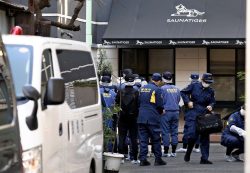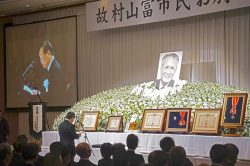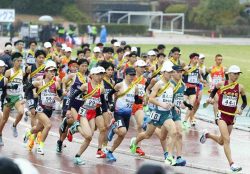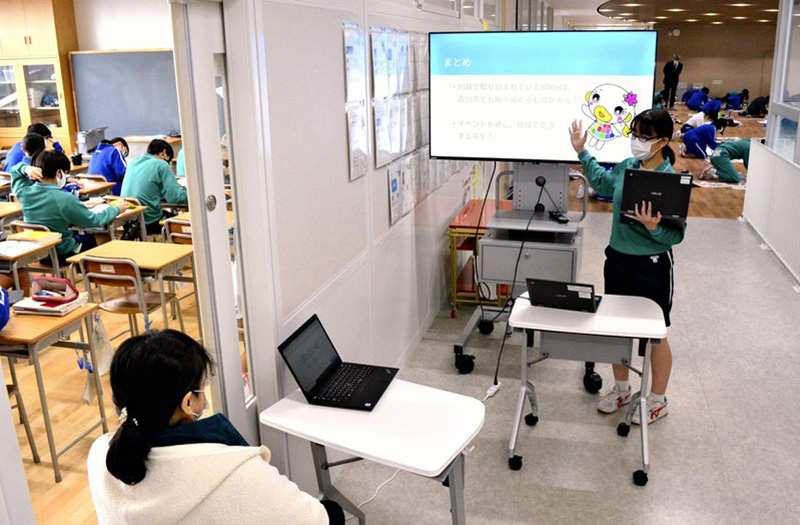
A student delivers a presentation to her teacher in a corridor outside her classroom at Yoshikawa City Junior High School in Saitama Prefecture on Dec. 7, as students from another class take calligraphy lessons in a common space behind her.
11:53 JST, December 30, 2021
More and larger educational materials, not to mention the pandemic, are changing classroom settings in elementary and junior high schools across the country.
Trial and error in search of a better learning environment continues at schools, with some offering classes in corridors and common spaces, and others adopting tools to make students’ desks more freely usable.
On Dec. 7 at Yoshikawa City Junior High School in Saitama Prefecture, each student of a third-year class took turns presenting a report on an out-of-school practical experience to their teacher in the corridor. Other students of the class were either preparing for or reviewing their presentations in the actual classroom.
At the same time, students in another class were taking calligraphy lessons in a common space down the corridor.
The classroo originally the school had placed desks in pairs next to each other to seat 37 students.
As a measure to prevent infections with the novel coronavirus, the Education, Culture, Sports, Science and Technology Ministry has asked schools to space students’ desks more than 1 meter apart. The school has followed the ministry’s request, though it has made it difficult for students to move around.
The school opened in spring 2020 with a common space on each floor, which is allocated to each grade. As the corridors are also 3 meters wide, and with about 40 movable desks and chairs on each floor, the school decided to make use of the corridors and common spaces for classwork, group study and other activities.
“This has been possible because our school is new and structured so that movable furnishings can be readily used,” said Assistant Principal Shinichi Nomiyama.
Limited area
Although the number of unused classrooms is increasing amid the low birth rate in Japan, there has been hardly any change in the dimensions of a regular classroom.
In 1950, the standard design of a classroom was set at 9 meters long by 7 meters wide. Even today, according to the education ministry’s survey on public school facilities, 69% of classrooms have an area of under 65 square meters. As tech-related equipment placed in classrooms, such as a storage area for tablets provided for each student, an electronic blackboard and a printer, has increased in number and volume, the space dedicated to learning has become smaller.
Efforts to make ampler and better use of the limited space in classrooms have been underway in various parts of the country.
At municipal-run Takata-Higashi Junior High School in Rikuzen-Takata, Iwate Prefecture, three classrooms were rearranged into two, separated by a movable partition, and between the classrooms is a multipurpose space.
In Tokyo, municipal-run Komagata Junior High School in Taito Ward has placed lockers for students’ bags in the corridor.
Crowded desktops
There are also challenges posed for classroom desks as student textbooks have become bigger and notebooks or tablets for online learning also need space.
The surface of a classroom desk was previously set at 60 centimeters wide by 40 centimeters deep, according to an old Japanese Industrial Standards specification. To handle the bigger size of children’s physique and their textbooks, a new JIS specification in 1999 stated the size of desktops should be at least 65 centimeters wide by at least 45 centimeters deep. At present, around 50% of schools have adopted desks in line with the new JIS specification.
ms in this school are 64 square meters in area, which is considered average, and
Textbooks have been changing, from mainly A5 size (148 x 210 millimeters) to B5 (182 x 257), while there has been an increase in supplementary materials in A4 (210 x 297).
Since April 2021, tablets for online learning have also been distributed to each student.
“When we consider the educational effect on students, it is better to provide bigger desks,” said a 58-year-old principal at an elementary school in the northern Kanto region where desks in line with the old JIS specification are still being used. “But it is financially difficult for us to provide all the students with the new desks.”
At Harayama Elementary School in Inzai, Chiba Prefecture, attachments to increase desktop space were adopted for all students’ desks in July 2021. The attachments increase the depth by 10 centimeters and have a frame to prevent items from falling off.
Sota Takahashi, a sixth grader, said he could not place his pencil case on a regular desk even if he folded the textbook and notebook and placed them on top of each other. So, he used to place only the necessary number of writing instruments on the desk.
“Now, I can place my textbook and notebook, together with a tablet, all at the same time, making it easier to study,” the 12-year-old boy said happily.
The attachment was jointly developed by TFabWorks and Uchida Yoko Co. and put on the market in May. About 50,000 units have already been used at elementary, junior and senior high schools in Tokyo and 44 other prefectures.
Hiroyuki Matsumoto, principal of the municipal-run school in Inzai, said, “Our children have become able to concentrate on studying, as they are no longer bothered by how to manage their use of desktop space.”
A panel of experts at the education ministry compiled an interim report in August calling on the nation to increase its support to local governments toward the development of an educational environment conducive to new ways of learning, such as using tablets for online education.
Panel member Satoru Nagasawa, a professor emeritus at Toyo University, said, “New style of education emphasizes cooperative learning such as group work, and there has been a limit to implement the new style in a conventional classroom.”
Nagasawa went on to say: “Local governments should, for their part, adopt such leading examples as making use of corridors. The central government should also properly extend financial support to them, perhaps for renovations to improve the learning environment, or for construction of or extensions to buildings.”
"Society" POPULAR ARTICLE
-

M4.9 Earthquake Hits Tokyo, Neighboring Prefectures
-

Israeli Tourists Refused Accommodation at Hotel in Japan’s Nagano Pref., Prompting Protest by Israeli Embassy and Probe by Prefecture
-

M7.5 Earthquake Hits Northern Japan; Tsunami Waves Observed in Hokkaido, Aomori and Iwate Prefectures
-

Tsukiji Market Urges Tourists to Avoid Visiting in Year-End
-
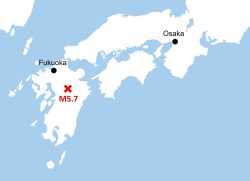
M5.7 Earthquake Hits Japan’s Kumamoto Pref., Measuring Upper 5 Intensity, No Tsunami Expected
JN ACCESS RANKING
-

Keidanren Chairman Yoshinobu Tsutsui Visits Kashiwazaki-Kariwa Nuclear Power Plant; Inspects New Emergency Safety System
-

Imports of Rare Earths from China Facing Delays, May Be Caused by Deterioration of Japan-China Relations
-

University of Tokyo Professor Discusses Japanese Economic Security in Interview Ahead of Forum
-

Tokyo Economic Security Forum to Hold Inaugural Meeting Amid Tense Global Environment
-

Japan Pulls out of Vietnam Nuclear Project, Complicating Hanoi’s Power Plans


